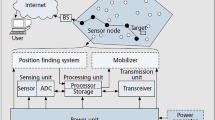Abstract
A way of optimizing energy consumption in mobile ad hoc networks is topology control. Various topology control algorithms have been proposed, but a few of them have used meta-heuristic methods such as genetic algorithms, neural networks, and learning automata. This paper presents a new algorithm based on the Bayesian pursuit (BPST) algorithm. The proposed algorithm predicts node mobility parameters by learning from the environment and uses these parameters to predict link availability duration. The algorithm, then, finds the paths with maximum lifetime by removing the links with a short lifetime using the local Dijkstra algorithm. In this way, an efficient and reliable topology is constructed. The paper also provides the proof of the convergence of the propounded BPST algorithm. The simulation results show that this algorithm can efficiently reduce energy consumption and improve throughput and end-to-end delay as two parameters of the quality of service.

















Similar content being viewed by others
References
Jeng, A. A.-K., & Jan, R.-H. (2011). Adaptive topology control for mobile ad hoc networks. IEEE Transactions on Parallel and Distributed Systems, 22(12), 1953–1960.
Li, N., Hou, J. C., & Sha, L. (2005). Design and analysis of an MST-based topology control algorithm. IEEE Transactions onWireless Communications, 4(3), 1195–1206.
Rodoplu, V., & Meng, T. H. (1999). Minimum energy mobile wireless networks. IEEE Journal on Selected Areas in Communications, 17(8), 1333–1344.
Li, L., & Halpern, J. Y. (2001). Minimum-energy mobile wireless networks revisited. In Paper presented at the IEEE International Conference on Communications, 2001. ICC 2001.
Miyao, K., Nakayama, H., Ansari, N., & Kato, N. (2009). LTRT: An efficient and reliable topology control algorithm for ad-hoc networks. IEEE Transactions on Wireless Communications, 8(12), 6050–6058.
Ansari, N., Cheng, G., & Krishnan, R. N. (2004). Efficient and reliable link state information dissemination. IEEE Communications Letters, 8(5), 317–319.
Nishiyama, H., Ngo, T., Ansari, N., & Kato, N. (2012). On minimizing the impact of mobility on topology control in mobile ad hoc networks. IEEE Transactions on Wireless Communications, 11(3), 1158–1166.
Yau, K.-L. A., Komisarczuk, P., & Teal, P. D. (2012). Reinforcement learning for context awareness and intelligence in wireless networks: Review, new features and open issues. Journal of Network and Computer Applications, 35(1), 253–267.
Siripongwutikorn, P., & Thipakorn, B. (2008). Mobility-aware topology control in mobile ad hoc networks. Computer Communications, 31(14), 3521–3532.
Shirali, N., & Jabbedari, S. (2013). Topology control in the mobile ad hoc networks in order to intensify energy conservation. Applied Mathematical Modelling, 37(24), 10107–10122.
Shirali, M., Shirali, N., & Meybodi, M. R. (2012). Sleep-based topology control in the ad hoc networks by using fitness aware learning automata. Computers & Mathematics with Applications, 64(2), 137–146.
Zarifzadeh, S., & Yazdani, N. (2013). Neighbor selection game in wireless ad hoc networks. Wireless Personal Communications, 70(2), 617–640.
Singh, V., & Kumar, K. (2011). Literature survey on power control algorithms for mobile ad-hoc network. Wireless Personal Communications, 60(4), 679–685.
Zhang, X. M., Zhang, Y., Yan, F., & Vasilakos, A. V. (2015). Interference-based topology control algorithm for delay-constrained mobile ad hoc networks. IEEE Transactions on Mobile Computing, 14(4), 742–754.
Zhao, L., Lloyd, E. L., & Ravi, S. (2010). Topology control in constant rate mobile ad hoc networks. Wireless Networks, 16(2), 467–480.
Zhang, X., Granmo, O.-C., & Oommen, B. J. (2011). The Bayesian pursuit algorithm: A new family of estimator learning automata. In Modern approaches in applied intelligence (pp. 522–531). Springer.
Zhang, X., Granmo, O.-C., & Oommen, B. J. (2013). On incorporating the paradigms of discretization and Bayesian estimation to create a new family of pursuit learning automata. Applied Intelligence, 39(4), 782–792.
Tsetlin, M. (1961). On behaviour of finite automata in random medium. Avtom I Telemekhanika, 22(10), 1345–1354.
Narendra, K. S., & Thathachar, M. A. (2012). Learning automata: An introduction. Chelmsford: Courier Corporation.
Thathachar, M., & Sastry, P. S. (1987). A hierarchical system of learning automata that can learn die globally optimal path. Information Sciences, 42(2), 143–166.
Thathachar, M. A. L., & Harita, B. R. (1987). Learning automata with changing number of actions. IEEE Transactions on Systems, Man and Cybernetics, 17(6), 1095–1100.
Varshavskii, V., & Vorontsova, I. (1963). On the behavior of stochastic automata with a variable structure. Avtomatika i Telemekhanika, 24(3), 353–360.
Thathachar, M. A., & Sastry, P. S. (1986). Estimator algorithms for learning automata.
Bai, F., & Helmy, A. (2004). A survey of mobility models. Wireless Adhoc Networks, 206, 147.
Liang, B., & Haas, Z. J. (1999). Predictive distance-based mobility management for PCS networks. In Paper presented at the INFOCOM’99. Eighteenth annual joint conference of the IEEE computer and communications societies. Proceedings. IEEE.
Torkestani, J. A., & Meybodi, M. R. (2011). A link stability-based multicast routing protocol for wireless mobile ad hoc networks. Journal of Network and Computer Applications, 34(4), 1429–1440.
Guan, Q., Ding, Q., & Jiang, S. (2009). A minimum energy path topology control algorithm for wireless multihop networks. In Paper presented at the proceedings of the 2009 international conference on wireless communications and mobile computing: connecting the world wirelessly.
Author information
Authors and Affiliations
Corresponding author
Additional information
Publisher's Note
Springer Nature remains neutral with regard to jurisdictional claims in published maps and institutional affiliations.
Rights and permissions
About this article
Cite this article
Rahmani, P., Haj Seyyed Javadi, H. Topology Control in MANETs Using the Bayesian Pursuit Algorithm. Wireless Pers Commun 106, 1089–1116 (2019). https://doi.org/10.1007/s11277-019-06205-4
Published:
Issue Date:
DOI: https://doi.org/10.1007/s11277-019-06205-4




